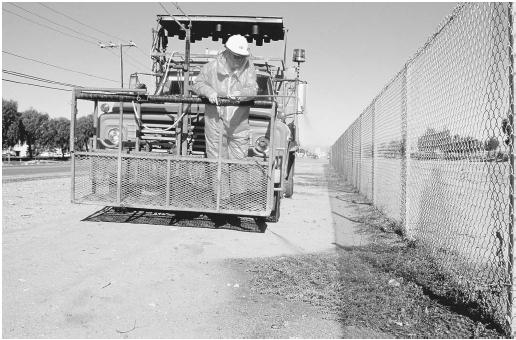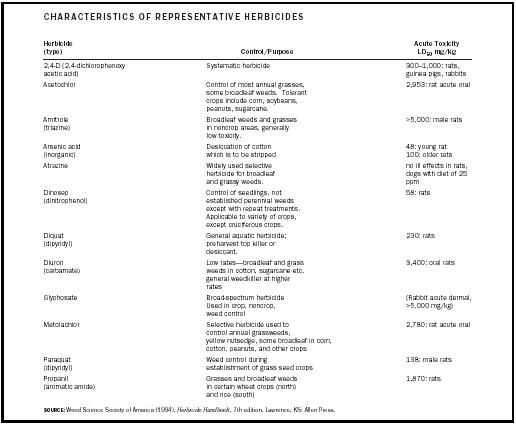Herbicides
Herbicides are chemicals used to destroy unwanted plants (terrestrial or aquatic) called weeds. Herbicides fall into two broad categories: inorganic (e.g., copper sulfate, sodium chlorate, and sodium arsenite) and organic (e.g., chlorophenoxy compounds, dinitrophenols, bipyridyl compounds, carbamates, and amide herbicides). Historically, inorganic compounds were the first available and the first used. There has been over a long period a continuous effort to develop herbicide compounds that are more selective—that affect weeds, as opposed to desirable plants.
Historical Developments
The decade 1890 to 1900 saw the introduction of sprays for controlling broad-leaved weeds in cereal crops, and the first efforts by the U.S. Army Corps of Engineers, using sodium arsenite, to control aquatic plants in waterways. In 1925 sodium chlorate (directly applied to soil) was first used for killing weeds. The earliest importation (from France) of sodium nitrocresylate, as the first selective weed killer, was in 1934. The year 1945 witnessed the introduction of organic herbicides and the advent of 2,4-D growth regulator (2,5-dichlorophenoxyacetic acid), subsequently leading to development of 2,4,5-T (2,4,5-trichlorophenoxyacetic acid). During the years 1965 to 1970, U.S. military forces used 2,4,5-T (Silvex) and related materials as defoliants in Vietnam, without knowing that an inevitable by-product of the synthesis of 2,4,5-T was a toxic substance, 2,3,7,8-tetrachlorodibenzodioxin (dioxin). There is still debate over the extent of damaging effects sustained by those airmen, soldiers, and civilians who were exposed to this material. Dioxin was present at a level of about 2 ppm (mg/kg sample) in some of the samples of 2,4,5-T (called Agent Orange), but other samples contained more than 30 ppm of the by-product. Dioxin was eventually found to be highly toxic to guinea pigs (the LD 50 value was 1 ppb, or 1 μ g compound/kg of sample), which led to the labeling of dioxin as "the world's most deadly poison," an impressive, if inaccurate, title (inaccurate because of a unique sensitivity of guinea pigs and because some natural toxins are known to be more potent).
The U.S. federal government's experience with 2,4,5-T demonstrates a significant principle: One must be concerned not only with the safety of the active components of commercial products, but also with the safety of byproducts that may be present in those products or that may form during natural degradation. Adherence to this principle is a major and costly challenge to those who develop herbicides, and concern for safety is partly responsible for the (at present) decreasing number of herbicides that are available for treating aquatic weeds.
It is thought that the first water hyacinths were introduced into the United States during an 1884 horticultural exposition in New Orleans, in

the course of which these plants, imported from Argentina, were given away as souvenirs. It is suspected that they were accidentally put into the St. Johns River in Florida and that they, shortly thereafter, multiplied. The plant grows (under optimal conditions) at the rate of 1.8 daughter plants per parent plant per week, and rapid growth generated dense mats that affected the navigation of boats on this river and others. In 1898 the U.S. Army Corps was given responsibility for maintaining the navigability of rivers, and aquatic plant control became its responsibility as well—a responsibility that has persisted to this day.
Herbicide Toxicity
Because plants and mammals differ in organization and physiology, it might be expected that herbicides would constitute only a slight chemical hazard to mammals. Whereas some herbicides have very low toxicities in mammals, others have considerable. A number of test species are used to appraise toxicity, and their sensitivities are graded as acute (short-term) LD 50 values.
LD 50 refers to the amount (LD or lethal dose) that will elicit the deaths of 50 percent of the test species. It is typically expressed as the weight of herbicide per kilogram of body weight. The smaller the LD value, the greater the toxicity.
The chlorophenoxy compounds 2,4-dichlorophenoxyacetic acid (2,4-D) and 2,4,5-trichlorophenoxyacetic acid (2,4,5-T) may be the most familiar herbicides. They have been used in agriculture (to eradicate broadleaf weeds) and to control woody plants in ditches and along highways. They act as growth hormones in many plants, and can evoke active plant growth in areas in which abnormal, twisted, or curtailed growth occurs. Massive doses

| CHARACTERISTICS OF REPRESENTATIVE HERBICIDES | ||
| Herbicide (type) | Control/Purpose | Acute Toxicity LD 50 mg/kg |
| SOURCE: Weed Science Society of America (1994). Herbicide Handbook , 7th edition. Lawrence, KS: Allen Press. | ||
| 2,4-D (2,4-dichlorophenoxy acetic acid) | Systematic herbicide | 300–1,000: rats, guinea pigs, rabbits |
| Acetochlor | Control of most annual grasses, some broadleaf weeds. Tolerant crops include corn, soybeans, peanuts, sugarcane. | 2,953: rat acute oral |
| Amitrole (triazine) | Broadleaf weeds and grasses in noncrop areas, generally low toxicity. | >5,000: male rats |
| Arsenic acid (inorganic) | Desiccation of cotton which is to be stripped | 48: young rat 100: older rats |
| Atrazine | Widely used selective herbicide for broadleaf and grassy weeds. | no ill effects in rats, dogs with diet of 25 ppm |
| Dinosep (dinitrophenol) | Control of seedlings, not established perennial weeds except with repeat treatments. Applicable to variety of crops, except cruciferous crops. | 58: rats |
| Diquat (dipyridyl) | General aquatic herbicide; preharvest top killer or desiccant. | 230: rats |
| Diuron (carbamate) | Low rates—broadleaf and grass weeds in cotton, sugarcane etc. general weedkiller at higher rates | 3,400: oral rats |
| Glyphosate | Broad-spectrum herbicide Used in crop, noncrop, weed control | (Rabbit acute dermal, >5,000 mg/kg) |
| Metolachlor | Selective herbicide used to control annual grassweeds, yellow nutsedge, some broadleaf in corn, cotton, peanuts, and other crops | 2,780: rat acute oral |
| Paraquat (dipyridyl) | Weed control during establishment of grass seed crops | 138: male rats |
| Propanil (aromatic amide) | Grasses and broadleaf weeds in certain wheat crops (north) and rice (south) | 1,870: rats |
of either 2,4-D or 2,4,5-T cause ventricular fibrillation in mammals. Lower doses cause contact dermatitis and chloracne (a kind of severe dermatitis) in workers who have contact with 2,4,5-T (which, as noted, may be mixed with 2,3,7,8-tetrachlorodibenzodioxin, or dioxin).
Dinitrophenols (as alkali salts or aliphatic amine salts) have long been used in weed control. Human exposure to these compounds has led to nausea, gastric upset, rapid breathing, tachycardia (rapid heartbeat), cyanosis, and ultimately coma. Death or recovery occurs within 24 hours.
Paraquat and diquat are the best-known examples of bipyridyl compounds. These compounds appear to act via a free radical mechanism, competing for and depriving plants of an essential reducing agent . These compounds are hazardous to human beings. About 200 deaths from accidental poisoning or suicide attempt occurred in the 1960s. The fatalities showed lung, liver, and kidney damage. Paraquat tends to become concentrated in the kidney, with the accumulation of toxic amounts in the lung being secondary to kidney damage.
Propanil is one of a group of amide herbicides (made from aniline treated with organic acids), and is used extensively to control weeds in rice crops. Rice itself contains an enzyme that hydrolyzes propanil to 3,4-dichloroaniline and propionic acid, and so it is resistant to the herbicide. Weeds, lacking this enzyme, are adversely affected by it. (Mammalian liver cells also have an enzyme that causes this hydrolysis.)
The effects of trace contaminants in herbicides are a major concern. For example, the use of Silvex was canceled by the U.S. Environmental Protection Agency in 1979 because the herbicide contained dioxin, a toxic. However, the Army Corps of Engineers argued against the cancellation, noting the overall U.S. waterways navigation benefits. The sum total of benefits of Silvex-based weed control were judged to correspond to approximately $40 million, and the benefit–cost ratio was about 11 to 1. Set against this must be the unknown costs of a toxic substance (dioxin), whose adverse effects are still being evaluated.
The entire world market for crop protection in 2000 was estimated to be $31 billion, and it probably will not grow significantly in the near future. Herbicides are sold as special formulations, and their use in the United States occurs only after extensive testing and governmental approval. Although new chemicals are being developed, the relatively static size of the herbicide market has resulted in a reduction in the number of agrochemical companies (through mergers and acquisitions). The number of new herbicides that will become available in the future will probably be a low one.
SEE ALSO Agricultural Chemistry ; Gardening ; Insecticides ; Pesticides .
Dean F. Martin
Barbara B. Martin
Bibliography
Baker, D. R., ed. (2002). Synthesis and Chemistry of Agrochemicals, Vol. VI. Symposium Series 800. Washington, DC: American Chemical Society.
Carson, Rachel (1962). Silent Spring. Boston: Houghton Mifflin.
Gough, M. (1986). Dioxin, Agent Orange: The Facts. New York: Plenum.
Klaassen, C. D., ed. (2001). Casarett and Doull's, 6th edition. New York: McGraw-Hill.
Weed Science Society of America (1994). Herbicide Handbook, 7th edition. Lawrence, KS: Allen Press.
Internet Resources
Weed Science Society of America. Available from http://www.wssa.net .